coolant temperature VOLKSWAGEN EOS 2013 1.G Owners Manual
[x] Cancel search | Manufacturer: VOLKSWAGEN, Model Year: 2013, Model line: EOS, Model: VOLKSWAGEN EOS 2013 1.GPages: 329, PDF Size: 5.17 MB
Page 214 of 329
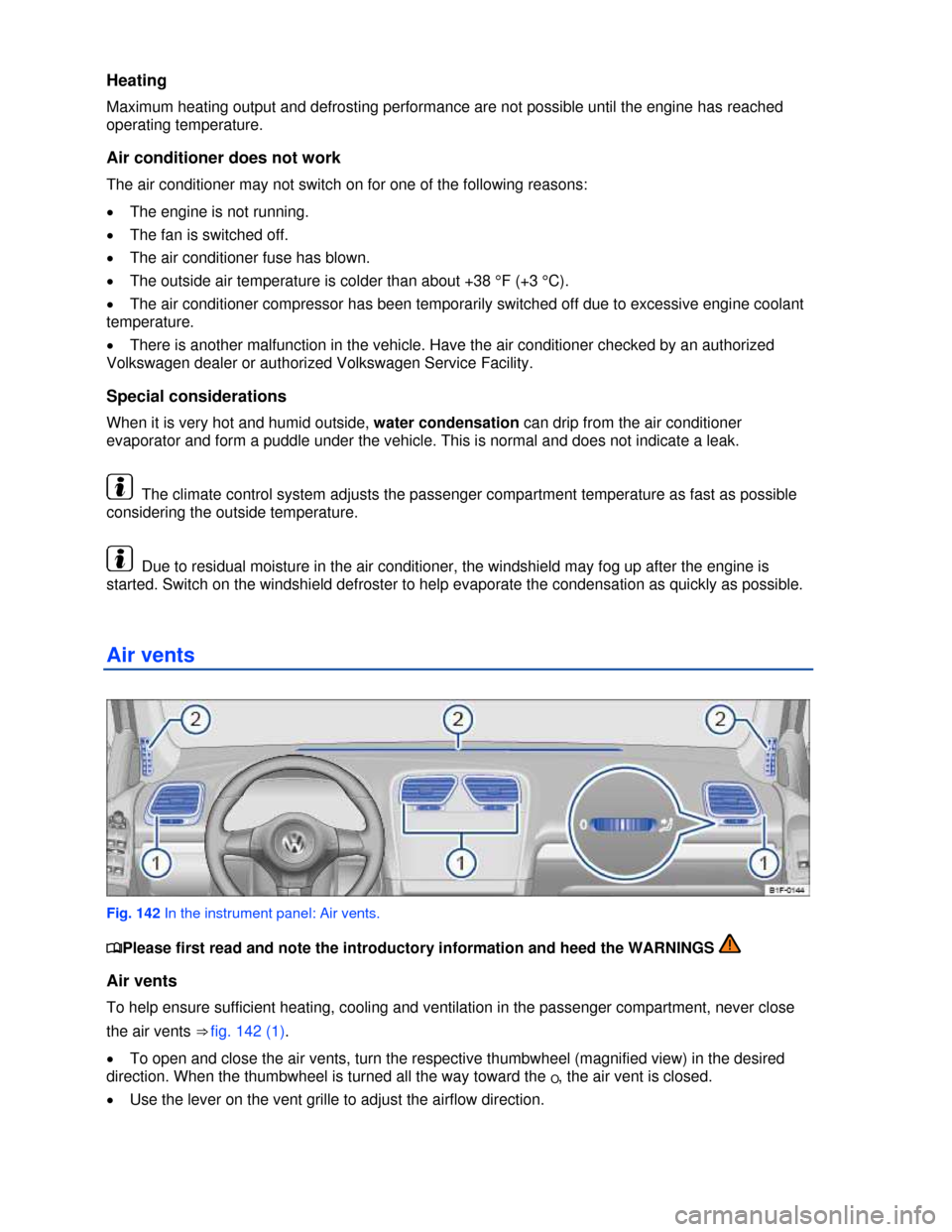
Heating
Maximum heating output and defrosting performance are not possible until the engine has reached
operating temperature.
Air conditioner does not work
The air conditioner may not switch on for one of the following reasons:
�x The engine is not running.
�x The fan is switched off.
�x The air conditioner fuse has blown.
�x The outside air temperature is colder than about +38 °F (+3 °C).
�x The air conditioner compressor has been temporarily switched off due to excessive engine coolant
temperature.
�x There is another malfunction in the vehicle. Have the air conditioner checked by an authorized
Volkswagen dealer or authorized Volkswagen Service Facility.
Special considerations
When it is very hot and humid outside, water condensation can drip from the air conditioner
evaporator and form a puddle under the vehicle. This is normal and does not indicate a leak.
The climate control system adjusts the passenger compartment temperature as fast as possible
considering the outside temperature.
Due to residual moisture in the air conditioner, the windshield may fog up after the engine is
started. Switch on the windshield defroster to help evaporate the condensation as quickly as possible.
Air vents
Fig. 142 In the instrument panel: Air vents.
�
Page 233 of 329
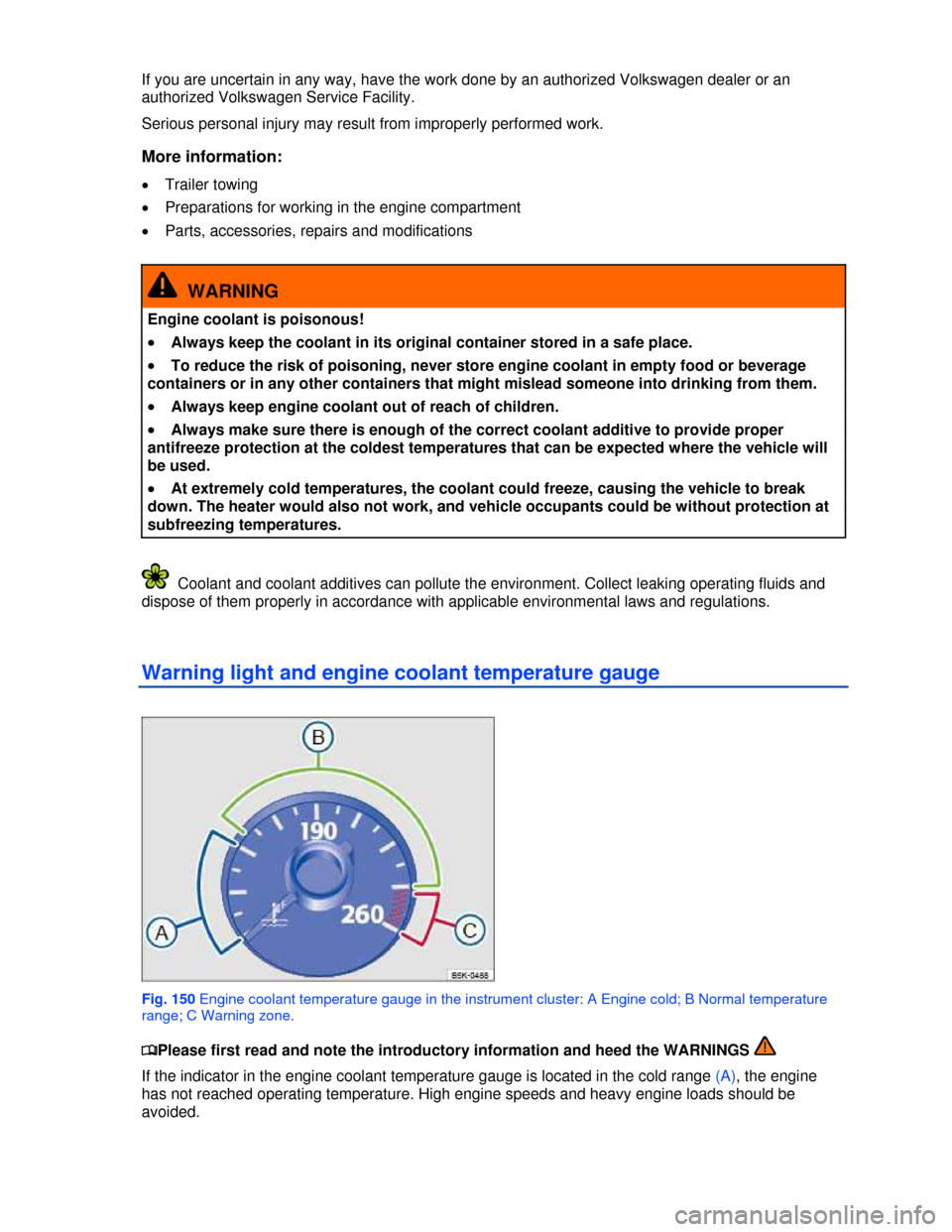
If you are uncertain in any way, have the work done by an authorized Volkswagen dealer or an
authorized Volkswagen Service Facility.
Serious personal injury may result from improperly performed work.
More information:
�x Trailer towing
�x Preparations for working in the engine compartment
�x Parts, accessories, repairs and modifications
WARNING
Engine coolant is poisonous!
�x Always keep the coolant in its original container stored in a safe place.
�x To reduce the risk of poisoning, never store engine coolant in empty food or beverage
containers or in any other containers that might mislead someone into drinking from them.
�x Always keep engine coolant out of reach of children.
�x Always make sure there is enough of the correct coolant additive to provide proper
antifreeze protection at the coldest temperatures that can be expected where the vehicle will
be used.
�x At extremely cold temperatures, the coolant could freeze, causing the vehicle to break
down. The heater would also not work, and vehicle occupants could be without protection at
subfreezing temperatures.
Coolant and coolant additives can pollute the environment. Collect leaking operating fluids and
dispose of them properly in accordance with applicable environmental laws and regulations.
Warning light and engine coolant temperature gauge
Fig. 150 Engine coolant temperature gauge in the instrument cluster: A Engine cold; B Normal temperature
range; C Warning zone.
�
Page 234 of 329

Under normal driving conditions, the needle should be in the middle of the gauge. The temperature
may go higher when the engine is working hard, especially in hot weather.
When the ignition is switched on, several warning and indicator lights come on briefly for a function
check. They go out after a few seconds.
The following table explains what to do if the engine coolant warning light ¿ does not go out a few
seconds after the engine is started or lights up or starts flashing while driving.
Flashes
Temperature
gauge needle
⇒ fig. 150
Possible cause Proper response
�~
(C)
Warning zone
Engine coolant
temperature too high.
�
Page 244 of 329
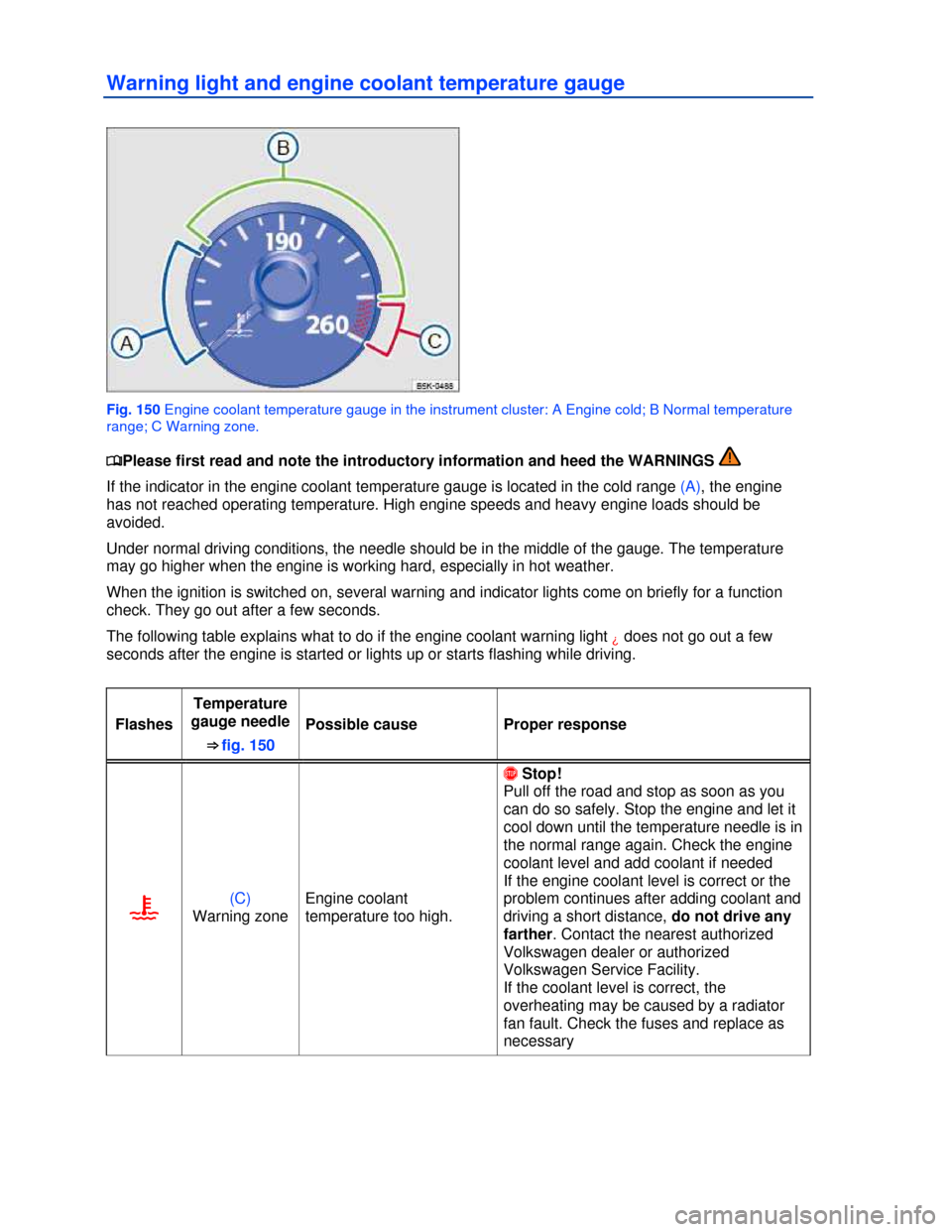
Warning light and engine coolant temperature gauge
Fig. 150 Engine coolant temperature gauge in the instrument cluster: A Engine cold; B Normal temperature
range; C Warning zone.
�
Page 245 of 329
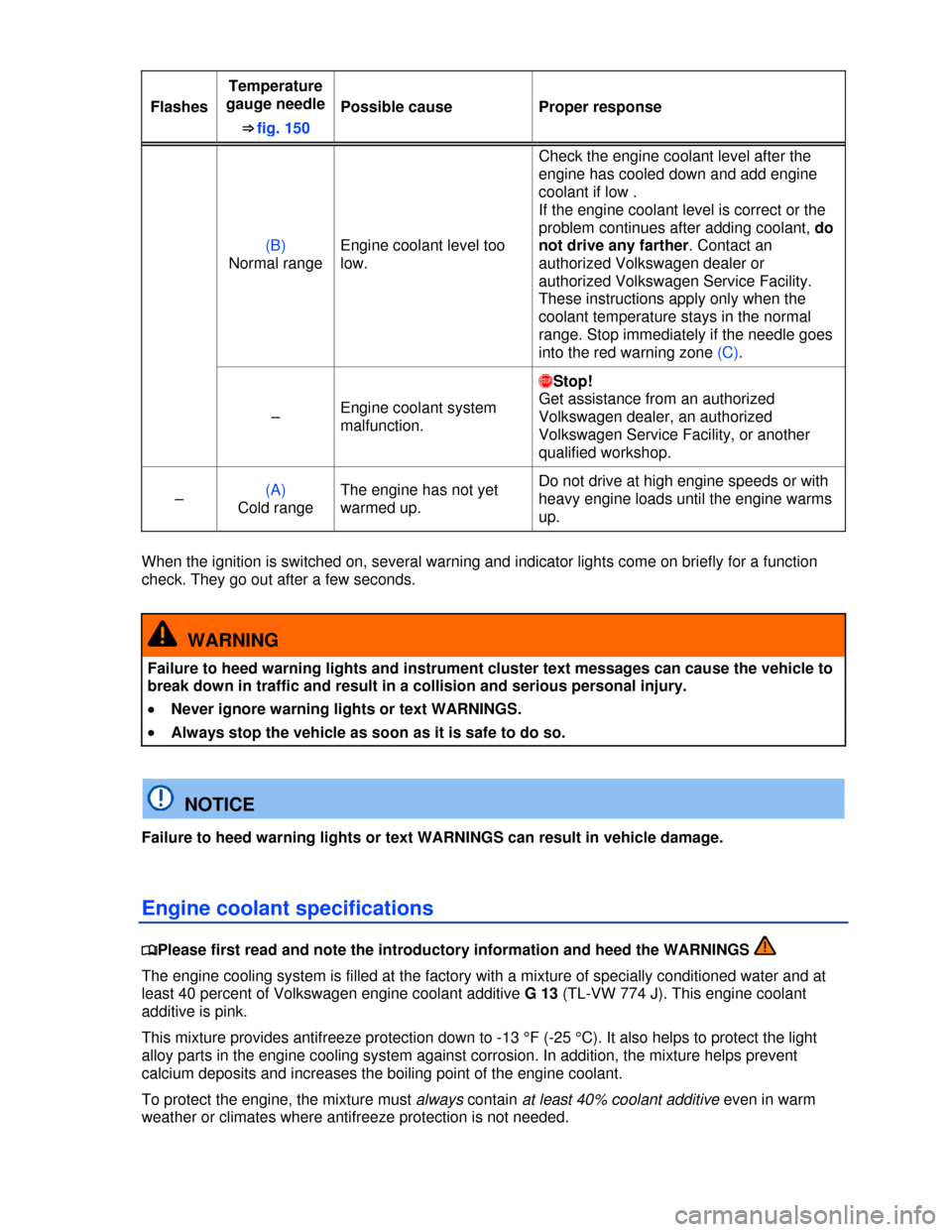
Flashes
Temperature
gauge needle
⇒ fig. 150
Possible cause Proper response
(B)
Normal range
Engine coolant level too
low.
Check the engine coolant level after the
engine has cooled down and add engine
coolant if low .
If the engine coolant level is correct or the
problem continues after adding coolant, do
not drive any farther. Contact an
authorized Volkswagen dealer or
authorized Volkswagen Service Facility.
These instructions apply only when the
coolant temperature stays in the normal
range. Stop immediately if the needle goes
into the red warning zone (C).
– Engine coolant system
malfunction.
�
Page 246 of 329
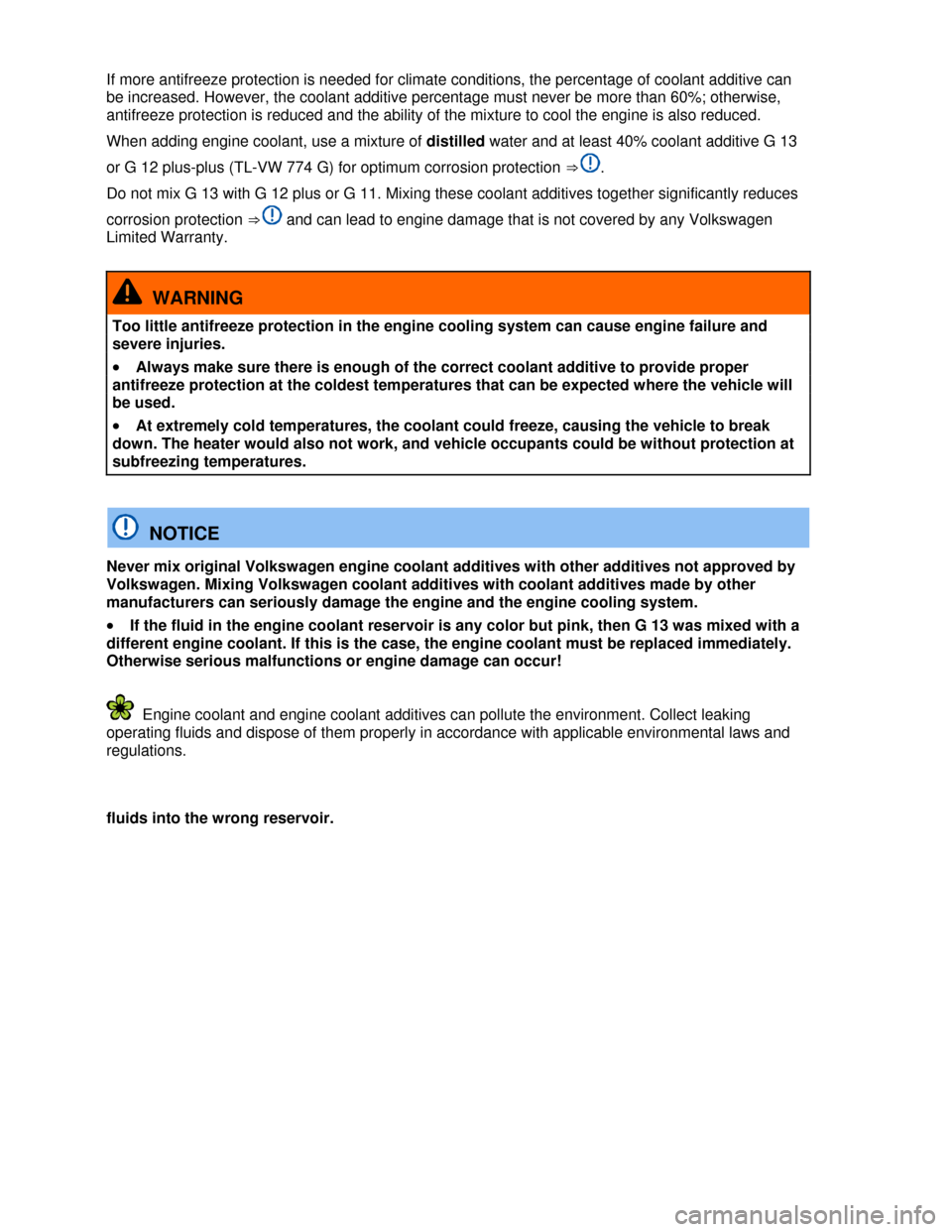
If more antifreeze protection is needed for climate conditions, the percentage of coolant additive can
be increased. However, the coolant additive percentage must never be more than 60%; otherwise,
antifreeze protection is reduced and the ability of the mixture to cool the engine is also reduced.
When adding engine coolant, use a mixture of distilled water and at least 40% coolant additive G 13
or G 12 plus-plus (TL-VW 774 G) for optimum corrosion protection ⇒ .
Do not mix G 13 with G 12 plus or G 11. Mixing these coolant additives together significantly reduces
corrosion protection ⇒ and can lead to engine damage that is not covered by any Volkswagen
Limited Warranty.
WARNING
Too little antifreeze protection in the engine cooling system can cause engine failure and
severe injuries.
�x Always make sure there is enough of the correct coolant additive to provide proper
antifreeze protection at the coldest temperatures that can be expected where the vehicle will
be used.
�x At extremely cold temperatures, the coolant could freeze, causing the vehicle to break
down. The heater would also not work, and vehicle occupants could be without protection at
subfreezing temperatures.
NOTICE
Never mix original Volkswagen engine coolant additives with other additives not approved by
Volkswagen. Mixing Volkswagen coolant additives with coolant additives made by other
manufacturers can seriously damage the engine and the engine cooling system.
�x If the fluid in the engine coolant reservoir is any color but pink, then G 13 was mixed with a
different engine coolant. If this is the case, the engine coolant must be replaced immediately.
Otherwise serious malfunctions or engine damage can occur!
Engine coolant and engine coolant additives can pollute the environment. Collect leaking
operating fluids and dispose of them properly in accordance with applicable environmental laws and
regulations.
fluids into the wrong reservoir.
Page 280 of 329
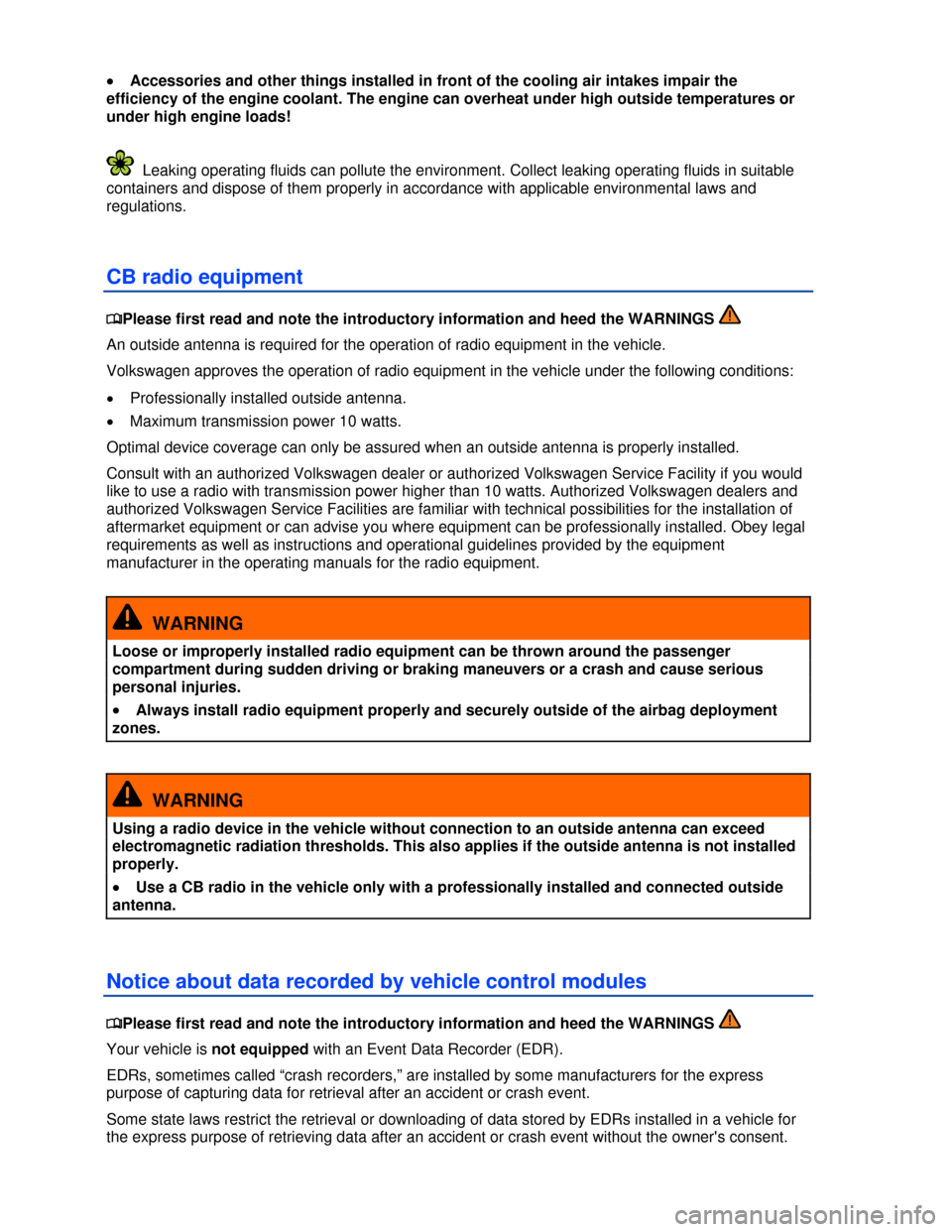
�x Accessories and other things installed in front of the cooling air intakes impair the
efficiency of the engine coolant. The engine can overheat under high outside temperatures or
under high engine loads!
Leaking operating fluids can pollute the environment. Collect leaking operating fluids in suitable
containers and dispose of them properly in accordance with applicable environmental laws and
regulations.
CB radio equipment
�